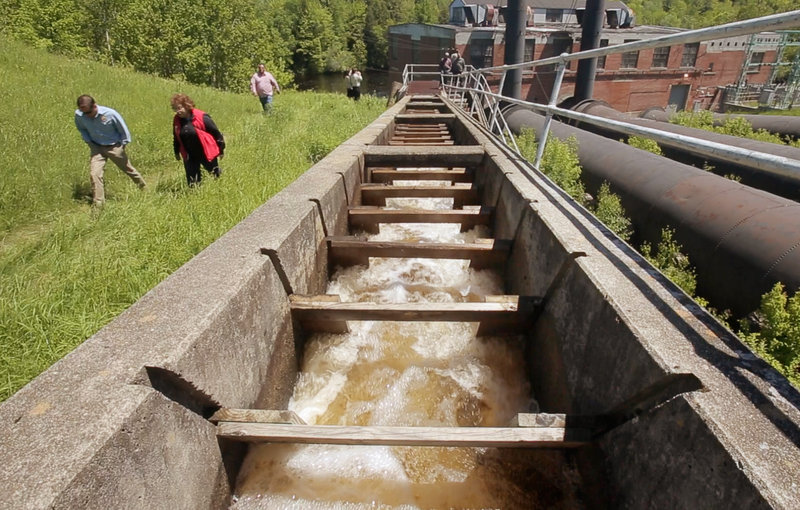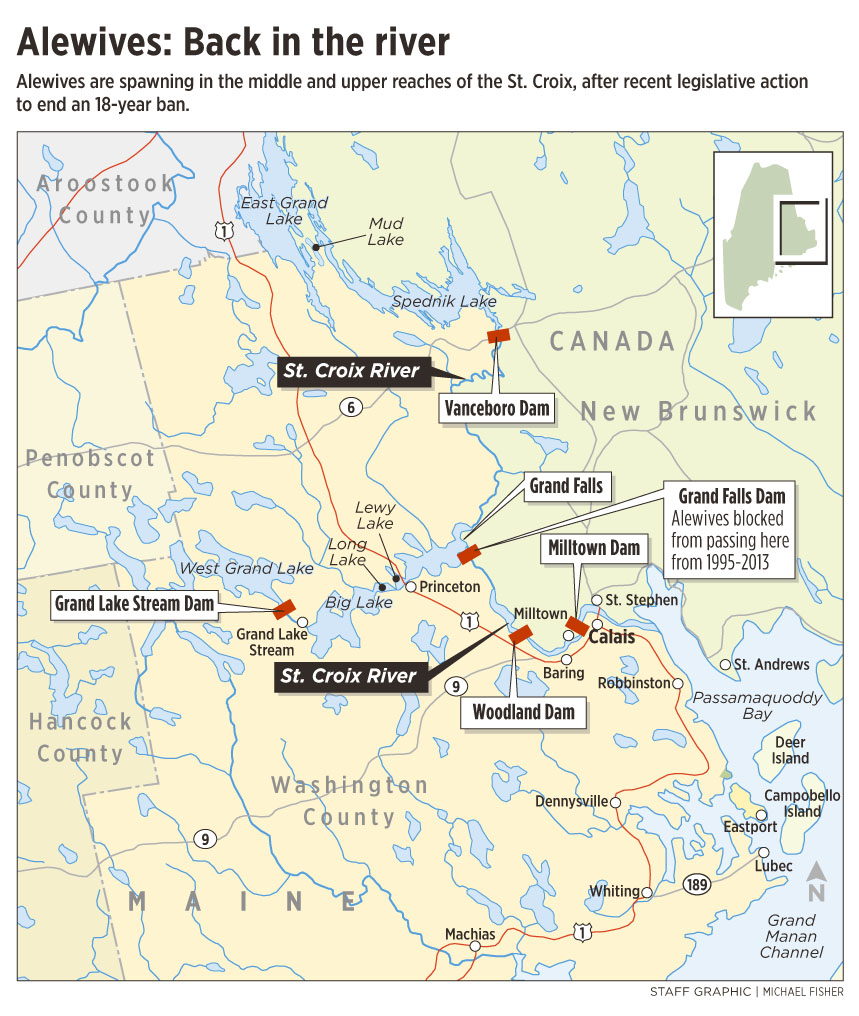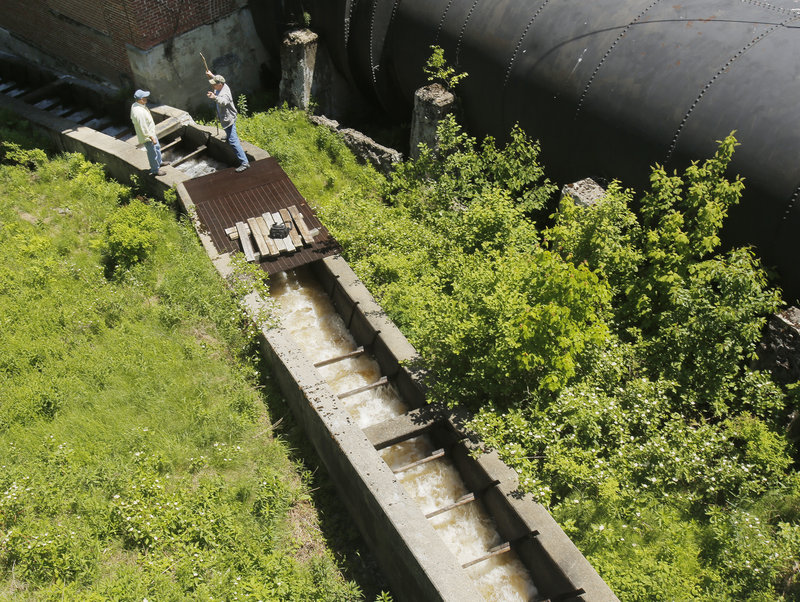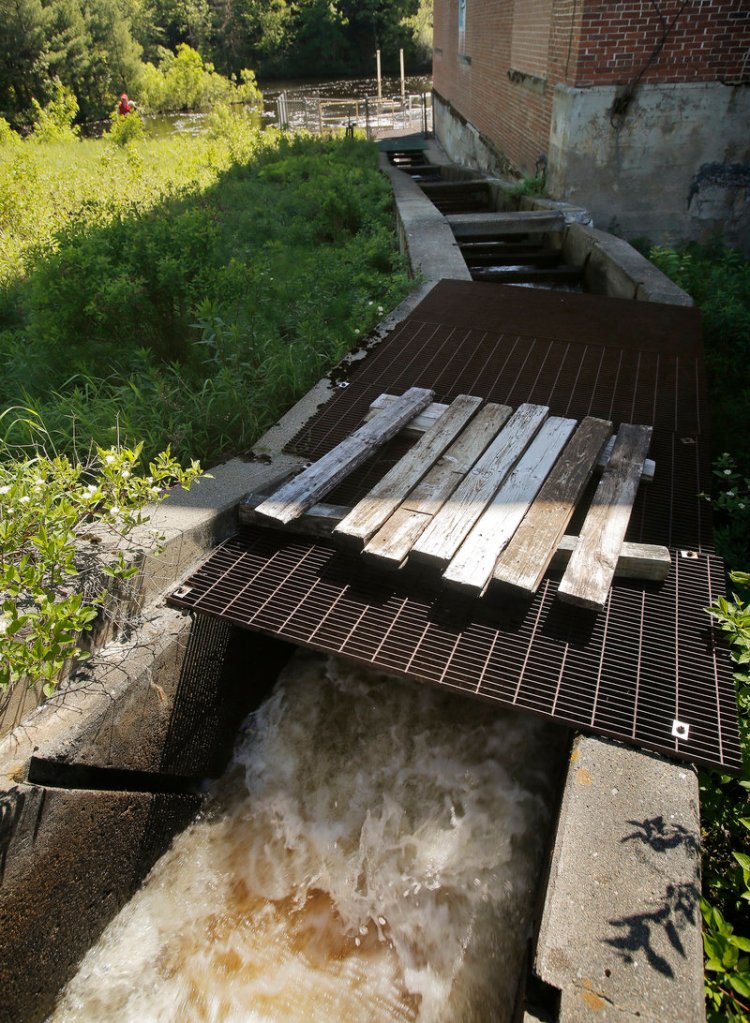BAILEYVILLE – Here in the shadow of the Grand Falls Dam power house, the fish ladder is clear for alewives to climb, the boards that once prevented their passage having been taken away.
From the top of the ladder, the schooling fish have access to a staggering expanse of spawning, nursing, and feeding habitat: more than 65,000 acres of river, stream, and lake bottom straddling the Maine-New Brunswick border.
Those who fought to persuade Maine lawmakers to let the fish over the dam have high hopes that the species will kick-start the recovery of living systems laid low by past overfishing, dam building and water pollution.
“The alewife is the fish that feeds all,” says Newell Lewey, a member of the Passamaquoddy tribal council, which supported free passage for the fish. “They are going to be beneficial for groundfish in Passamaquoddy Bay and for species inland, because they are food for others.”
Now — despite weeks of heavy rain impeding their travels — thousands of fish are on the move up the St. Croix River system, thanks to a change of heart by the Maine Legislature, which just a few years ago had banned them from the river.
“I am pleased that the political atmosphere was in favor of the alewives,” says Newell’s tribal council colleague Ed Bassett, who traveled to Augusta to ask legislators to let the fish pass. “This time the facts won out and fiction lost.”
It’s been quite an odyssey for the alewives, which are also known as “river herring.”
The fish spend most of their lives in the oceans but travel up freshwater rivers this time of year to spawn. An important source of food for larger fish, their numbers crashed after dams were constructed on Maine’s rivers in the 19th century.
Some scientists think their disappearance played a role in the destruction of Maine’s inshore cod stocks, and that their restoration to the Kennebec, Penobscot, St. Croix and other rivers could contribute to the recovery of commercial fish.
Alewives were effectively shut out of the St. Croix River from 1825 to 1981, first because of impassable dams, and later because of pollution from lumber and paper mills. Meanwhile, smallmouth bass were introduced to the region by late 19th century sport fishermen, supporting fishing camps and guides across the watershed.
But with construction of a better fishway at the dam at the mouth of the river in the early 1980s, the alewives annual run grew 13-fold to more than 2.6 million fish.
Then bass guides got worried about the possible effects on smallmouth bass and Augusta lawmakers stepped in, passing a 1995 law that ordered the fishways at Grand Falls and the Woodland dam be closed to the fish. The St. Croix alewife runs collapsed to just 900 fish in 2002, a decline of 99.7 percent.
The Legislature revisited the issue in 2008, but under pressure from guides and one faction of the Passamaquoddy Tribe, ultimately decided to leave the Grand Falls fishway closed, depriving the alewives of an estimated 94 percent of their habitat.
The result of these laws has been nothing short of catastrophic, says Sean Mahoney of the Conservation Law Foundation, who fought against them in Augusta and federal court. “If those were humans, that would be genocide — they tried to wipe them out,” he says.
But this year the Legislature effectively rescinded both laws, a move supported by saltwater fishermen, environmentalists, scientific studies, and the U.S. and Canadian federal governments. On May 7, alewives began entering the river, passing through a counting station at Milltown, New Brunswick, opposite Calais. Ironically, the weather turned against them.
Lee Sochasky, who has managed the Milltown count for more than two decades, says heavy rains and record high water levelskept alewives from entering the river for much of their time-sensitive spawning cycle.
“Just over 16,600 alewives made it upstream before the high flows, but many others that were waiting have missed their spawning ‘window’ and have now gone back to sea,” says Sochasky, who counted 36,168 last year. “Some of these might return next year to add to an expected large run of spawners in 2014. We have to wait and see what nature brings.”
(The fish are detained in a research trap at the top of the fishway, counted by hand daily, and released unharmed.)
There are no official monitoring stations at the other dams, and nobody knows for sure if the fish have passed up the Grand Falls fishway or another at the Vanceboro dam, 35 miles farther upriver.
“If there had been a large run, a general observation would have let one know if they were gathering at those dams,” Sochasky says, “but it was just too small a number of fish for someone to casually see what was going on with the flows as high as they were.”
Canadian officials confirmed that the fishway at the Vanceboro dam — which they control — is also open to the fish.
“The fish have open passage from there on up, and they can be free to do what they want to do and what nature dictates to them,” says Harvey Millar, Fisheries & Oceans Canada’s area director based in St. George, New Brunswick. “It’s a good thing for the fish, for Canada, and for the ecosystem of the river and the Bay of Fundy as well.”
The fish are not being allowed beyond the Grand Lake Stream dam in the western half of the watershed for unrelated reasons associated with a state fish hatchery.
Scientific projections suggest the newly opened sections of the St. Croix — which include Spednik Lake and Big Lake — could support annual runs in excess of 10 million fish. If that happens, the potential benefits to the region’s marine and riverine ecosystems could be tremendous, says Ted Ames, a Stonington-based groundfisherman-turned-fisheries researcher whose work on the collapse of inshore groundfisheries helped garner him a prestigious MacArthur Foundation “genius” grant.
“My historical work showed that these coastal populations of cod, haddock, white hake, and pollock lingered inshore as long as alewives remained in the area,” Ames says. Dams put an end to the alewives and, thus, much of the bigger fishes’ food supply in the late 19th century. “
Now that the fish are returning, Ames says “the potential is enormous.” He outlines the possible benefits: an abundant supply of lobster bait that could itself be a $1 million a year industry; a food base that might allow inshore cod, pollock, and haddock stocks to become re-established in eastern Maine; runs of alewives returning to sea that could provide cover for salmon.
“I’m convinced recovery of valuable predatory fish will happen,” Ames says. “Does that mean we will get to pre-Civil War abundances again? I don’t know. That’s looking at a crystal ball.”
Brian Altvater, a Passamaquoddy tribal member who helped launch the recent campaign to open the river to the fish, is also upbeat about the potential ecosystem — and socioeconomic — effects.
“If we don’t mess with nature, it will take care of itself, but when we plug the rivers with dams and abuse them, that’s when we get into trouble,” he says. “Whatever we do to our land and our rivers, we do to ourselves.”
Ames, Bassett and others say bass fishermen will eventually discover they have won as well, noting that alewives and bass coexist in rivers and lakes throughout Maine and that the scientific consensus is that they help, not harm, one another.
But bass fishing guides fear the consensus is wrong and they have continued to argue that the alewives will compete with small bass for food and even that they are an invasive species that never lived in the river.
These are the most hectic and lucrative weeks for the region’s bass guides and few responded to interview requests. Those who did declined to comment because they were considering further legal challenges to the free passage of the alewives.
“They’re all out on the water, so I actually haven’t talked to any of those guys,” says Don Kleiner, executive director of the Maine Professional Guides Association, which is based in Wilton, a 3½-hour drive to the west. “Our issues with the alewives’ passage are economic, and it’s unfair to even speculate what the impact will be. Who knows the answer at this moment?”
Jeffrey Pierce, Dresden-based executive director of the Alewife Harvesters of Maine, says the two fish happily co-exist but that the bass guides have backed themselves into a corner. “Deep down inside they have to know they’re wrong, but they just can’t come out and say that,” Pierce says. “I hope they stop wasting their money trying to block this and instead use it to try to encourage tourism.”
“I think they will come to an understanding first that the alewives are not going to be a threat,” says Lewey. “Later they’ll learn that alewives can be beneficial to their industry.”
Colin Woodard can be contacted at 791-6317 or at:
cwoodard@pressherald.com
Send questions/comments to the editors.






Success. Please wait for the page to reload. If the page does not reload within 5 seconds, please refresh the page.
Enter your email and password to access comments.
Hi, to comment on stories you must . This profile is in addition to your subscription and website login.
Already have a commenting profile? .
Invalid username/password.
Please check your email to confirm and complete your registration.
Only subscribers are eligible to post comments. Please subscribe or login first for digital access. Here’s why.
Use the form below to reset your password. When you've submitted your account email, we will send an email with a reset code.